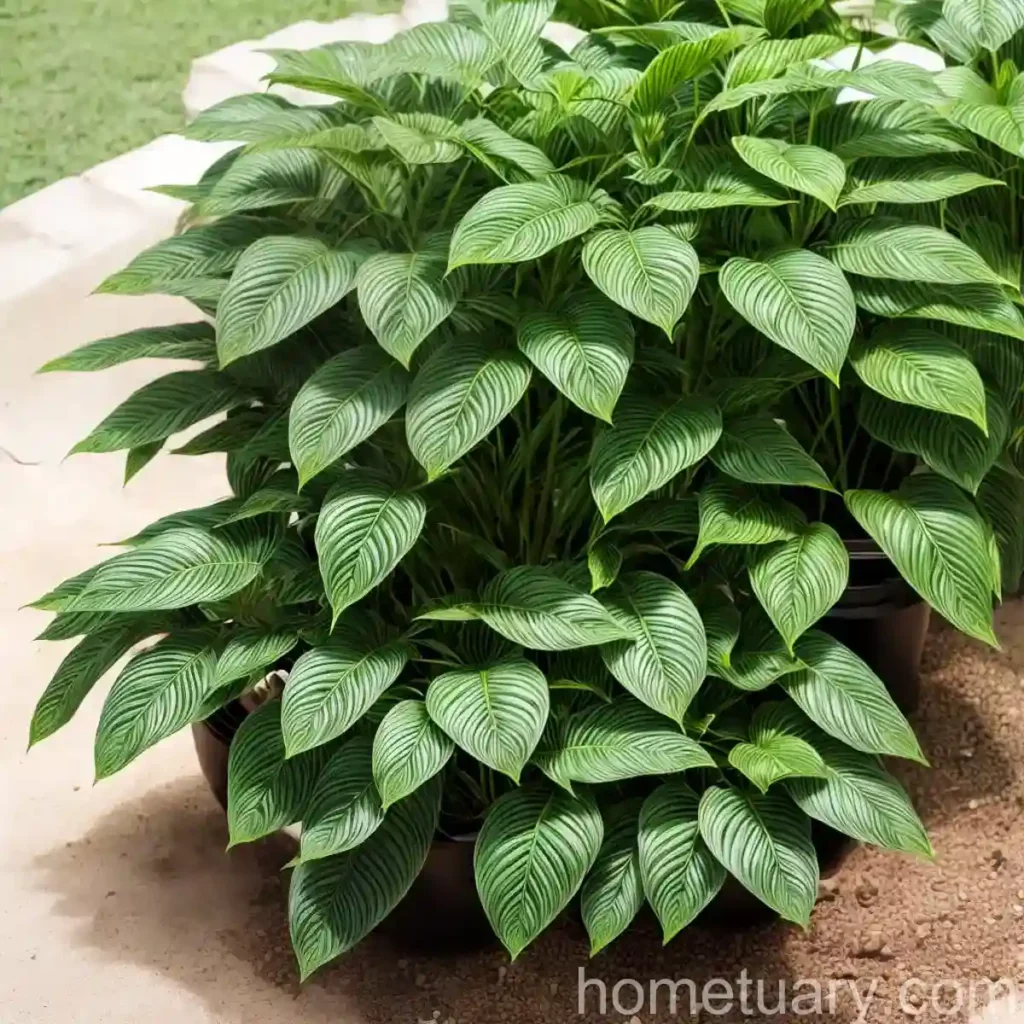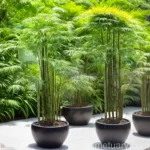All About Kamuro-zasa (Pleioblastus viridistriatus)
Kamuro-zasa, scientifically known as Pleioblastus viridistriatus, is a stunning and versatile plant that has gained popularity for its ornamental and landscape uses. This beautiful bamboo species is a perfect choice for both indoor and outdoor plant enthusiasts. In this comprehensive guide, we will delve into the characteristics, care tips, propagation methods, and various uses of kamuro-zasa. Whether you are a seasoned gardener or just starting your plant journey, there is something exciting to learn about this fascinating plant.
What is Kamuro-zasa (Pleioblastus viridistriatus)?
Kamuro-zasa, or Pleioblastus viridistriatus, is a unique variety of bamboo known for its striking appearance and ease of cultivation. It is a clump-forming bamboo, meaning it grows in dense, compact clumps, making it an excellent choice for adding greenery and texture to various settings. Native to Japan, kamuro-zasa is a popular choice for landscaping and ornamental purposes, thanks to its vibrant green and yellow-striped leaves and its manageable size.
Key Takeaways – Kamuro-zasa (Pleioblastus viridistriatus)
- Scientific Name: Pleioblastus viridistriatus
- Common Name: Kamuro-zasa
- Plant Type: Clump-forming bamboo
- Origin: Japan
- Foliage: Green and yellow-striped leaves
- Uses: Ornamental, landscaping, indoor and outdoor plant
- Growth Habit: Compact clumps
- Hardiness: Suitable for various climates
- Versatility: Ideal for containers and garden beds
- Attributes: Low maintenance and visually appealing
Now that we have an overview of kamuro-zasa, let’s explore the various aspects of its care, including culture, uses, and maintenance practices.
Culture
Understanding the cultural requirements of kamuro-zasa is essential for creating an environment where it can thrive. From its water needs to sunlight requirements, providing the right cultural conditions is crucial for the plant’s health and growth.
Water
Kamuro-zasa, like many bamboo species, appreciates consistent moisture levels. While it is essential to keep the soil consistently moist, it is equally important to ensure good drainage to prevent waterlogged conditions. Regular watering during dry spells and monitoring the soil moisture will help maintain the plant’s vitality.
Sunlight
This bamboo variety thrives in partial to full shade, making it a great choice for areas with limited direct sunlight. While kamuro-zasa can tolerate some sun, providing dappled light or filtered sunlight will help maintain its vibrant foliage colors and overall health.
Fertilizer
When it comes to fertilizing kamuro-zasa, a balanced, slow-release fertilizer applied in spring can support healthy growth. Look for a fertilizer specifically formulated for ornamental grasses or bamboo to ensure proper nutrient balance. Always follow the manufacturer’s recommendations for application rates and frequency.
Soil
Well-draining, fertile soil is ideal for kamuro-zasa. A slightly acidic to neutral soil pH is preferred, and adding organic matter such as compost can improve soil structure and fertility. Before planting, prepare the soil by amending it with organic material to create an optimal growing environment for the bamboo.
Pruning
While kamuro-zasa is a relatively low-maintenance plant, periodic pruning can help manage its size and shape. Remove any damaged or discolored leaves, as well as any dead or overcrowded stems to promote healthy growth. Regular maintenance pruning will also help prevent the plant from becoming too dense, allowing for better air circulation within the clumps.
Propagation
Propagating kamuro-zasa can be achieved through division, which involves separating the rhizomes to create new plants. This method is best done in spring, as the plant begins its active growth phase. To propagate kamuro-zasa through division:
- Dig up the Clump: Carefully dig up a mature kamuro-zasa clump, ensuring that you do not damage the rhizomes.
- Separate the Rhizomes: Using a sharp, clean tool, divide the clump into sections, ensuring that each division has a good balance of roots and shoots.
- Replant the Divisions: Plant the divided sections in prepared soil, water thoroughly, and provide appropriate care to encourage establishment.
Container Popularity
Kamuro-zasa’s compact growth habit and visually appealing foliage make it an excellent choice for container gardening. Whether you have limited outdoor space or want to add a touch of greenery to your patio or balcony, growing kamuro-zasa in containers offers flexibility and versatility. When selecting a container, choose one with adequate drainage holes and use a well-draining potting mix to ensure optimal growing conditions.
Common Diseases
Like all plants, kamuro-zasa is susceptible to certain diseases, with fungal infections being the most common concern. Keeping the plant in good health by providing appropriate cultural conditions and avoiding overwatering can help prevent many disease issues. However, being aware of potential diseases and their symptoms is crucial for timely intervention and management.
Disease Diagnosis
Some common diseases that may affect kamuro-zasa include:
- Leaf Spot: Characterized by small, dark spots on the leaves, leaf spot diseases can affect the overall appearance of the plant. Good air circulation and avoiding overhead watering can help prevent this issue.
- Powdery Mildew: A fungal disease that presents as a powdery white substance on the leaves, powdery mildew can impact the plant’s vigor. Proper spacing and maintaining humidity levels can aid in prevention.
- Root Rot: Often caused by excessive moisture and poor drainage, root rot can lead to wilting and yellowing of leaves. Ensure proper drainage and avoid waterlogging to minimize the risk of root rot.
Regularly inspecting the plant for any signs of disease and promptly addressing any issues can help maintain kamuro-zasa’s health and visual appeal.
Common Pests
While kamuro-zasa is relatively pest-resistant, it may encounter certain pests that can impact its growth and overall vigor. Being vigilant and proactive in pest management is key to preventing infestations and minimizing potential damage.
Some common pests that may affect kamuro-zasa include:
- Aphids: These tiny, soft-bodied insects feed on plant sap and can cause stunted growth and leaf distortion.
- Spider Mites: These pests are known for creating fine webbing on the plant and can cause yellowing of leaves and reduced plant vigor.
- Scale Insects: Scale insects can attach themselves to the plant and feed on sap, leading to yellowing of leaves and wilting.
Implementing cultural practices that promote plant health, such as proper watering and adequate sunlight, can help reduce the likelihood of pest infestations. Additionally, using insecticidal soaps or horticultural oils can offer effective control for certain pests while minimizing harm to beneficial insects.
Botanist’s Tips
For those looking to cultivate kamuro-zasa or enhance their existing plants, here are a few additional tips from botanists and horticulturists:
- Mulching: Applying a layer of organic mulch around the base of kamuro-zasa can help conserve soil moisture, suppress weed growth, and add organic matter to the soil as the mulch breaks down.
- Regular Monitoring: Keeping a close eye on the plant for any changes in growth, foliage color, or the presence of pests and diseases can help address issues promptly and maintain plant health.
- Winter Protection: In regions with cold winters, providing some protection for kamuro-zasa, such as mulching around the base of the plant, can help insulate the roots and protect them from harsh temperatures.
Implementing these tips alongside regular care practices can contribute to the overall health and vitality of kamuro-zasa.
Fun Facts
To add some intrigue to our exploration of kamuro-zasa, here are a few fascinating and lesser-known facts about this captivating bamboo plant:
- Kamuro-zasa is often used in traditional Japanese gardens for its visual appeal and ability to create serene, green spaces.
- The variegated foliage of Pleioblastus viridistriatus adds a unique and eye-catching element to landscapes and garden beds.
- In the practice of Feng Shui, kamuro-zasa is believed to bring positive energy and is often incorporated into designs to create harmonious outdoor spaces.
- While kamuro-zasa is primarily known for its outdoor uses, it can also thrive as an indoor plant when provided with adequate light and moisture.
- The rhizomes of kamuro-zasa are a crucial part of its growth and expansion, making division a viable propagation method for obtaining new plants.
These engaging facts underscore the versatility and cultural significance of kamuro-zasa in various settings and traditions.
Links to External Resources
For further exploration of kamuro-zasa, propagation techniques, and its use in landscaping and gardens, here are some valuable resources to dive deeper into the world of this captivating bamboo plant:
By leveraging these resources, you can expand your knowledge of kamuro-zasa, its care requirements, and its role in enhancing outdoor spaces and gardens.
In closing, kamuro-zasa, or Pleioblastus viridistriatus, stands as an enchanting and versatile plant that offers an array of aesthetic and practical benefits. From its cultural preferences to its propagation methods and unique uses, this bamboo species continues to captivate plant enthusiasts and landscape designers alike. Whether you’re drawn to its ornamental charm, its role in traditional Japanese gardens, or its potential to bring positive energy into outdoor spaces, kamuro-zasa presents an array of opportunities for exploration and enjoyment. As you embark on your plant journey, consider incorporating kamuro-zasa into your green spaces and discover the beauty and vitality it brings to your surroundings.
Remember, as you care for and appreciate kamuro-zasa, you are not only nurturing a plant but also cultivating a deeper connection to nature and the wonders it holds. Let the vibrant green and yellow-striped leaves of kamuro-zasa inspire awe and appreciation, serving as a reminder of the beauty and resilience found in the natural world.















